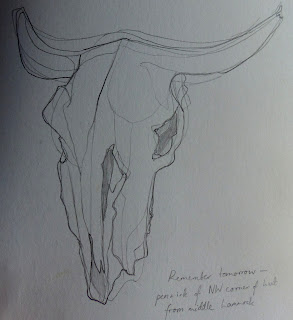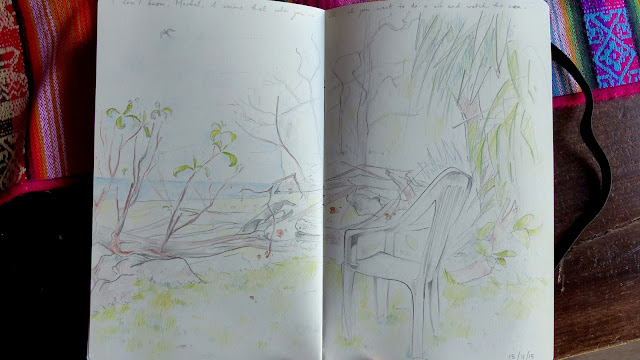Sunday, 29th November:
Miriam's phone crackled and blared into life at four o'clock. On the end of the line was Pablo, our
guia (guide); he wanted us to know that he was running late, and would be outside my flat in five minutes.
'No worries', Miriam assured him, as I scrambled to get my things together. Outside, the sky was the colour of ink. Quito twinkled quietly under a blanket of clouds.
At 4:15 a.m., we were racing out of Quito on the Pan-American highway, Pablo at the wheel and our gear in the back. Our challenge for today was to attempt the 5126-metre summit of Illiniza Norte. The Illinizas come as a pair, and the north summit is recommended as a trek for those who want to acclimatise for higher mountains such as Cotopaxi and Cayambe. We had seen the former at five a.m. (a hazy pyramid against a lightening blue) and by half past the hour had crossed the tracks of the
Tren Crucero, the tourist toy that forms a lazy trail across the country. Now, at 5:45, here we were at the entrance of
Reserva Ecologica Los Illinizas. A chain across the entrance, an empty ranger's station, a sign saying the park opened at 8. An inauspicious start that was not to be borne by Pablo, who banged on the windows of the station until a sleepy ranger came to let us through.
 |
| An erupting Volcan Cotopaxi above the clouds at 7 a.m. |
Up the rutted track we bounced; kept in suspense by the health of the wheezing 4x4. We rounded the corner and suddenly, there they were, lit up by the colours of dawn: Illiniza Norte and Illiniza Sur. They were an imposing pair of siblings, up to say their prayers at first light.
Sur was snow-capped, icy and regal;
Norte appeared the friendlier of the two, cheerful and ruddy-sloped. The word
Illiniza apparently means 'masculine hill' in Kunza, although I'd say that with her glacial beauty
Sur looked like a glamorous older sister.
 |
| Illiniza Sur with Laguna Illinizas to the right. |
And so we climbed. Our early start had served us well, for we had a clear view of the mountains, and the path grew upwards so that they were always in our frame of view. I settled in for the walk, and began to make their acquaintance. Thoughts and judgements passed over me like the clouds over
Sur, but by the time we reached the refuge, I thought I knew them pretty well...
Illiniza Sur (5248m) is imposing, dashing, and breathtakingly beautiful. An almost perfect pyramid, it is covered on several sides by ice shelves that curve deeply and vanish cruelly. It's a climb that requires skill and technical expertise, that few can claim to own; on our ascent of Illiniza Norte, we saw only one set of footprints marking the way up to the Sur summit. Many clouds struggled over the summit during the course of our day. The first ones that made it were reamed out to a fine candy-floss, and formed a beautiful swirl; like a Mr Whippy ice-cream, or Donald Trump's toupee. Pablo informed us that these are a sure sign of strong winds at the summit. Kudos to those who made it.
 |
| Summit of Illiniza Sur, with Mr. Whippy clouds. |
Illiniza Norte (5126m) is less imposing than its taller sister. It is a friendly mountain of excellent character, standing slightly shorter, much broader, and built with a long ridge running over its back and interlocking plates of hexagonally-jointed lava columns on its flanks. These features combined with the warm colours of the mountain (orange, rust, ochre) to give it an incandescent halo; in the early morning, with the sun's rays warming away the hail that had settled on the upper flanks, the mountain looked like a sleeping armadillo, yet to come out of its shell.
 |
| Early view of eastern face of Illiniza Norte, with last night's hail still resting. |
Our path changed from a
quebrada (stream) to some scree slopes. My heart was beating loudly in my ears. We were, after all, at great altitude. The mountains before us were amazing; but it was incredible as well to think that as we climbed the sweet and unimposing slopes of the valley below, we were actually at greater altitude than almost the whole of Europe. Mid-morning we arrived at
Refugio de Nuevos Horizontes (New Horizons Refuge), located at 4750 metres. It was small and sweet, mostly taken up by six enormous bunk beds that could hold two double mattresses each. The rest of the hostel was a poky, sooty little kitchen, which held supplies for hot drinks and chocolate. There had been eight guests last night, who had left between half-two and three to attempt the south summit. We learnt this from the ranger-in-residence, a sly and laconic soul who seemed happy with his own company; he asked us a few questions with sleepy eyes, and then left us to fix our tea while he curled up sleepily in his tiny bunk above the kitchen. The bunk caught the warm up-drafts from the kettle; give him a ray of sunshine and a ball of string, I thought, and he'd be in heaven.
 |
| Refugio Nuevos Horizontes in front of Illiniza Norte. |
After our break at the
Refugio we continued, leaving behind the grey scree of the lower slopes and moving into the warm oranges and reds of the true Illiniza Norte. Pablo pointed out the tiny lake behind us.
Laguna Illinizas. Too green to be natural? He'd swam in it before, on his way to one of his summit attempts that were now so numerous that he'd lost count. The lake marked the sweet spot between the two wildly different characters of the Illinizas.
 |
| The meeting of the two mountains. |
We roped up for the last push to the summit. My heart began to pound louder. A few days before our hike, piqued (peaked?) by a fit of curiosity, beforehand, I had looked up the route guide for Illiniza Norte:
'Start at the
La Virgen parking lot', twittered the internet, 'and continue to the
Refugio de Nuevos Horizontes. Continue climbing beyond the lake, and you will approach the
Paso de la Muerte [Death Step]. It's quite a good idea to rope up on this; one wrong foot will mean death as you plunge thousands of feet below. Many climbers have lost their lives on Illiniza Norte, particularly intermediate climbers who underestimate the difficulty of the climb. Don't forget to enjoy yourself!'
Aye, right.
Believe it or not,
Paso de la Muerte was not as bad as the name suggested; proven by my being alive to write this. We got to the summit, and I put some mementos on the iron cross. A Canadian flag, as a shout-out to where I first mountaineered; and a bracelet in the colours of Ecuador. A good-luck charm left at the summit, to thank the Illinizas for a wonderful day.
 |
| The summit cross. |
Shout-out to Pablo, our wonderful guide. He taught us many things: rope management, pacing, how to stay cheerful on Death's Step, and in addition, a bucket-load of Spanish. Fortunately we had no problems on the
Paso de la Muerte: I would have hated to have asked him to repeat '
Watch out! Falling rock!' in English. Here are a list of all the words I learned:
Fox (
zorro); Ecuadorian lupins (
sachachocha); exposed (
expuesto); effort (
esfuerzo); to sweat (
sudar); to cool (
enfriar); multi-pitch; scree (
moraina); peas (
arvejas); beans (
frejoles); ice (
hielo); saddle (
ensillada); step (
paso); knife-ridge (
cuchilla); rope management (
manejo de la cuerda); helmet (
casco).
Stats:
We climbed 5126 metres: Illiniza Norte is the 8th highest peak in Ecuador. I hope to climb the 3rd (Cayambe) in two weeks.
We took 8 hours and 35 minutes to climb Illiniza Norte. This can be broken down as: leave
La Virgen parking lot 06:20, first break around 07:45 by boulder, reached shoulder by 09:00,
refugio 09:15 - 09:40, ropes on around 10:20, first peak 11:10 (after
Paso de la Muerte), summit 12:05, bottom of scree slope 13:20, passed
quebrada around 14:00, arrival at
La Virgen parking lot 14:55.
Good reading resources:
1.
https://en.wikipedia.org/wiki/Illiniza
2.
http://www.summitpost.org/illiniza-norte-iliniza-norte/151055
3.
http://volcano.si.edu/volcano.cfm?vn=352041
4.
http://thecloudocean.com/2014/02/19/illinizanorte/
Pictures to include: Panorama including Cotopaxi, Illinizas, Corazon (1); Refugio and IN (2), Cotopaxi erupting (3); IN close-up at dawn (route drawn on?) (4); Laguna with 2 mountains meeting (5); Cross w remnants on it (6); Travel buddies on scree (7)



































